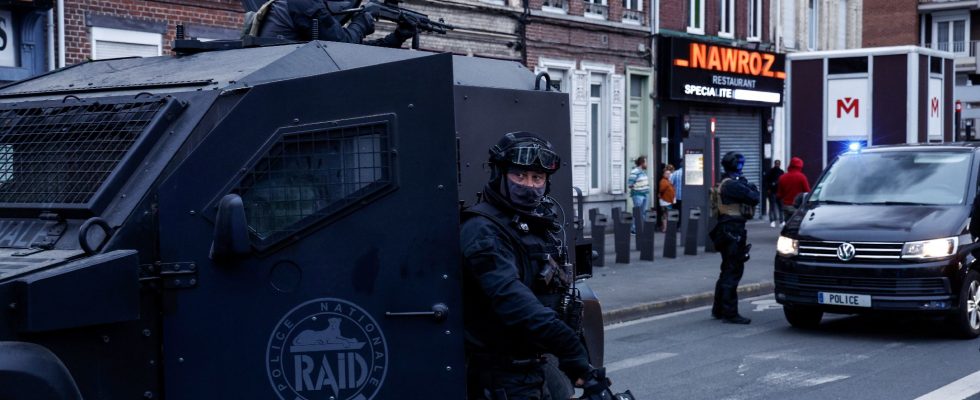The anger does not fall after the death of young Nahel. Damage to public buildings, looting and scuffles shook many towns in the Paris region and in the provinces overnight from Thursday to Friday, for the third consecutive evening after the death on Tuesday in Nanterre of the 17-year-old minor killed by a policeman who was charged and imprisoned for intentional homicide. Seized by an amateur video, the point-blank shot of the official on the teenager during a roadside check continues to set fire to many working-class neighborhoods in the country.
Emmanuel Macron will chair a new interministerial crisis cell on Friday at 1:00 p.m. in Paris, for the second time in two days.
40,000 police and gendarmes and 667 arrests
To stem a “generalization” of urban violence, the authorities have mobilized 40,000 police and gendarmes, as well as elite intervention units such as the Raid and its black armored vehicles or the National Gendarmerie Intervention Group (GIGN ), deployed in several cities on Thursday. Night curfews have been decreed in Clamart and Meudon (Hauts-de-Seine), Neuilly-sur-Marne (Seine-Saint-Denis) and Compiègne (Oise). And in the North, the prefecture has banned all gatherings in places and mobilized a helicopter and drones.
Despite this massive deployment, violence and damage were reported Thursday evening in multiple cities. 667 people were arrested last night across the country, Gérald Darmanin announced on Friday.
From Nanterre to Marseille, France continues to burn
This was the case in the heart of Paris, at Les Halles and in the rue de Rivoli which leads to the Louvre, but also in the Parisian suburbs, in the urban area of Rouen, in Nantes and in Brest, where the sub-prefect Jean- Philippe Setbon described clashes between police and small, very mobile groups”. As the day before, the police were also targeted, trash cans, cars and buses burned, especially in Villeurbanne (Rhône) or Aubervilliers ( Seine-Saint-Denis).
Again, public buildings were also targeted by groups often hooded or hidden under hoods, such as the town hall of the priority district of Argon in Orléans. “The police office located at the Laherrère pole in Pau” was for example targeted by a molotov cocktail, according to the prefecture of Pyrénées-Atlantiques. In the city center of Marseille, it is the storefront of the municipal library of the Alcazar which was damaged, according to the town hall. A short distance away, on the Old Port, scuffles pitted the police against a group of 100 to 150 people who allegedly tried to set up barricades.
In Seine-Saint-Denis, “almost all the municipalities” were affected, often lightning actions, many public buildings targeted such as the town hall of Clichy-sous-Bois and shops looted, according to a police source. In Nanterre, the Hauts-de-Seine prefecture which has become the epicenter of the violence, fireworks and grenades exploded in the popular district of Pablo Picasso where the killed teenager lived. The Research and Intervention Brigade (BRI) of the Paris police headquarters, famous for having attacked the jihadists who occupied the Bataclan on November 13, 2015, deployed for a moment at the entrance to the city and its famous cloud towers, supported in the sky by a helicopter. Around 3:00 a.m., 245 arrests took place in Paris and in the inner suburbs, according to the police headquarters.
The white march ends in clashes
It was from Nanterre that a “white march” in memory of Nahel left in the afternoon which brought together 6,200 participants, according to the police headquarters, to cries of “justice for Nahel” and “never again That”. “I don’t blame the police, I blame a person, the one who took my son’s life,” said the victim’s mother, Mounia M., on the microphone of the program “C à you” on France 5. The march she was leading ended in confusion with clashes. Street furniture was destroyed, cars burned and the Resistance and Deportation monument was damaged.
Since Nahel’s death on Tuesday, schools and public buildings have been the target of the anger of young residents of working-class neighborhoods and set on fire in multiple cities in France, recalling the riots that engulfed France in 2005 after the death of two youths pursued by the police. “Scenes of violence” against “institutions and the Republic” which are “unjustifiable”, castigated Emmanuel Macron.
The imprisoned policeman
The tragedy at the origin of the conflagration occurred near the Nanterre-Préfecture RER station, during a police check on the car driven by Nahel, a minor known for refusing to comply. “The prosecution considers that the legal conditions for the use of the weapon” by the policeman who fired the shot “are not met”, declared Thursday morning the public prosecutor of Nanterre, Pascal Prache.
This 38-year-old policeman was indicted for intentional homicide and placed in pre-trial detention in the afternoon. A video, authenticated by AFP, showed that this national police motorcyclist positioned alongside his car held Nahel at gunpoint after a chase and then fired at point-blank range. The case has reignited controversy over the action of law enforcement in France, where a record number of 13 deaths were recorded in 2022 after refusals to comply during traffic checks.
